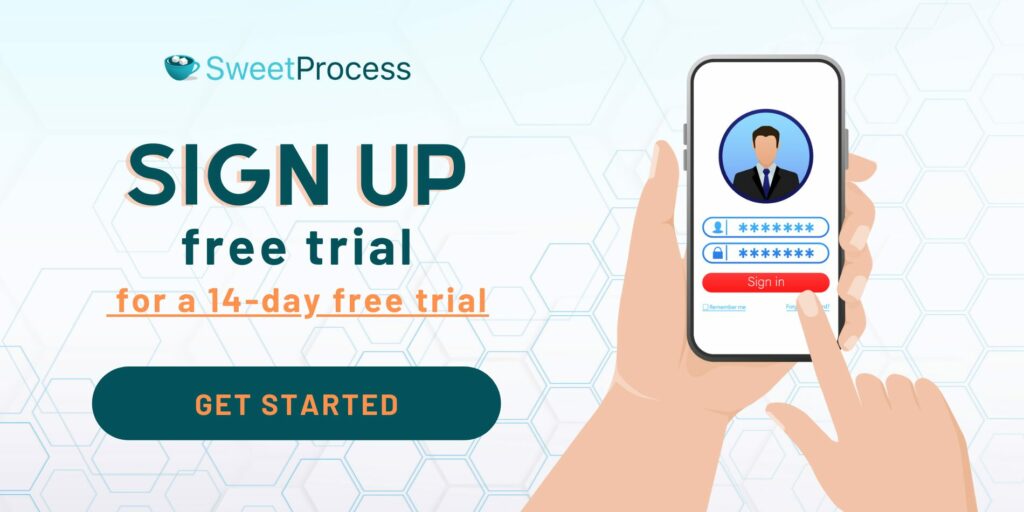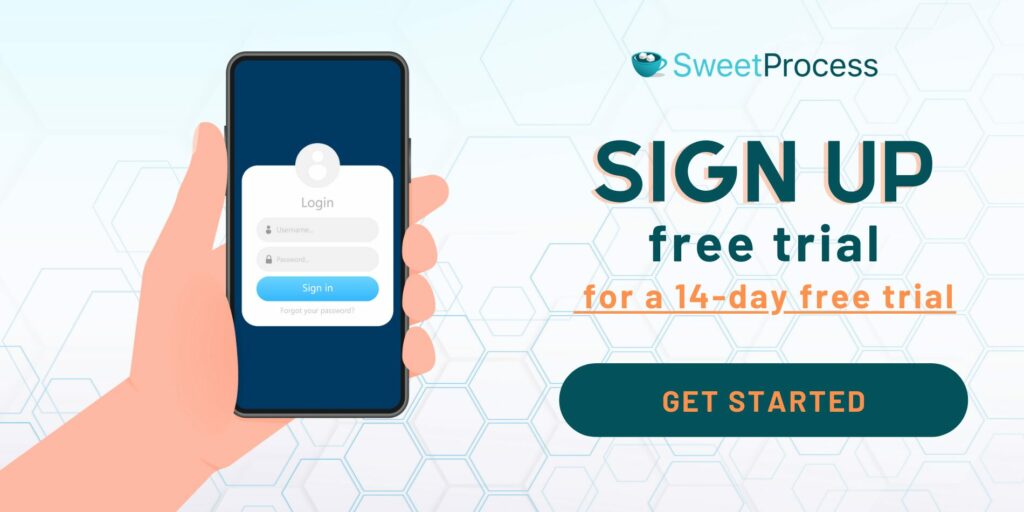Last Updated on February 14, 2025 by Owen McGab Enaohwo
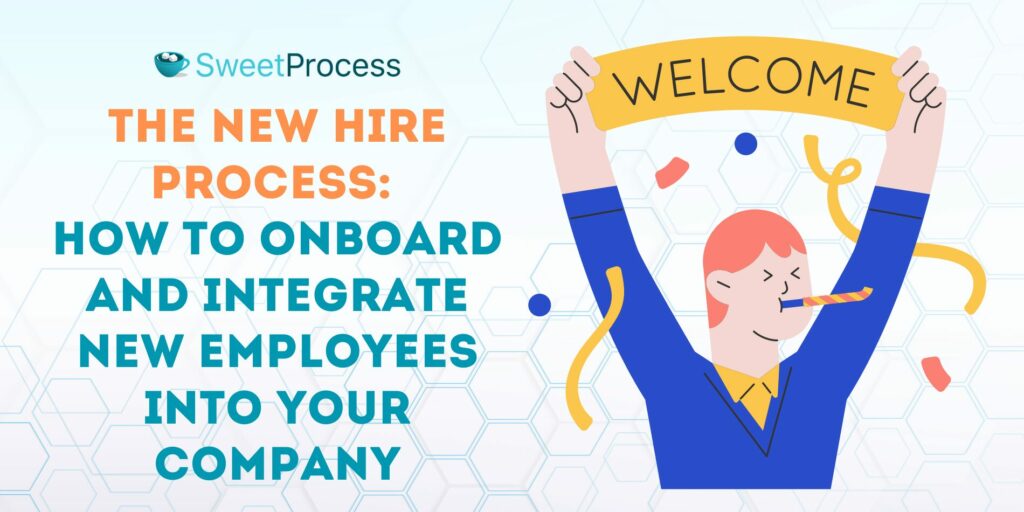
Congratulations! You found the perfect candidate to fill a key role in your company. But the work isn’t over yet.
You need an efficient onboarding process.
A successful hire isn’t just about finding the right talent. It’s about integrating them seamlessly into your team and setting them up for success. Remember that your onboarding process during the first weeks or months can make or break your new hires.
A study by Forbes and OnePoll shows that 81% of new employees felt overwhelmed by the onboarding process, which led to lower productivity and unsatisfied workers. When this happens in your organization, your new hires might leave prematurely, and you’ll have to start the hiring process again.
However, when your onboarding process is done properly, you can provide ongoing support and help new hires feel confident and engaged in their new positions. So, how can you implement an effective new hire process? In this article, we’ll explore:
- What the new hire process entails
- The importance of having a new hire process roadmap
- Key steps to follow in the onboarding process
- Best practices and challenges during the hiring process
- Best employee onboarding tool to use
Your organization needs a tool to simplify its onboarding process. With SweetProcess, you can create detailed checklists and procedures and document workflows during the entire training period. Sign up for the free 14-day trial period of SweetProcess today!
Table of Contents
What Does the New Hire Process Entail?
Why the New Hire Process Is Important
How to Onboard New Employees To Your Company: A 9-Step Guide
7 Effective Ways to Integrate New Employees Into Your Company
How to Ensure a Seamless New Hire Process Using SweetProcess
9 Best Practices and Tips for a Successful New Hire Process
7 Common Challenges You Might Encounter During the New Hire Process
Bring Onboard New Employees Seamlessly With SweetProcess
What Does the New Hire Process Entail?
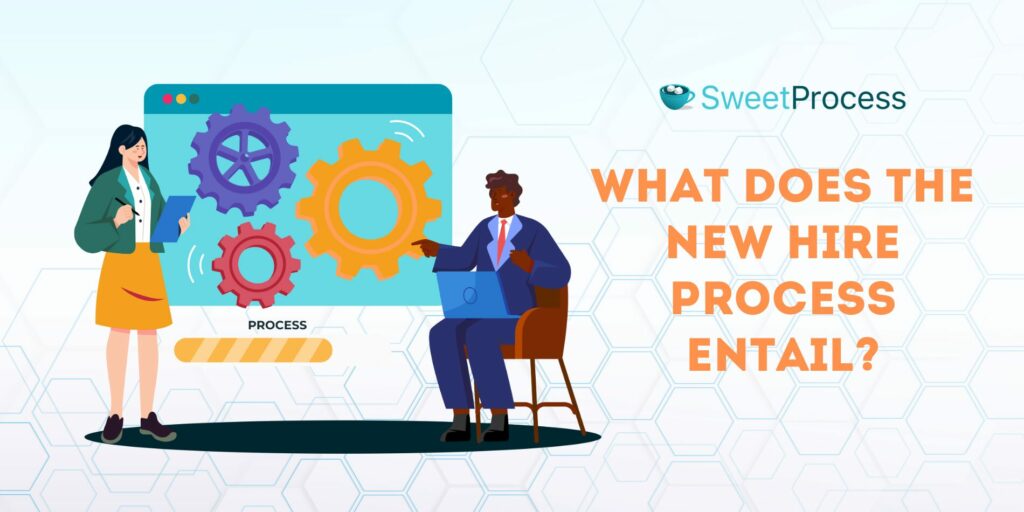
Once you hire a new team member, you need a streamlined process to make them feel welcome. This new hire process includes hiring, onboarding, and integrating a new employee into your company.
Think of it as constructing a building, where each phase is critical to creating a strong and lasting structure.
Hiring
At the hiring stage, you identify and attract the right talent for your team. Companies with a good hiring process have an easier onboarding program for new employees. It’s the first step in laying a good foundation to help you select candidates who have the potential to uphold the company’s goals.
To hire the best team:
- Develop a clear job description
- Leverage your current employees
- Evaluate whether the interviewee aligns with the company’s goals
Onboarding
Once the right candidate is hired, the onboarding phase begins. This is where the real building takes shape. Imagine onboarding as the construction process—erecting the beams and walls supporting the entire structure.
During employee onboarding, new hires are introduced to the company culture, policies, and specific roles through structured orientation and training programs. To make the process more seamless, ensure your company has a new hire onboarding checklist that acts as a guide. This phase is vital for helping them feel integrated and ready to contribute effectively.
Integration
Companies with a solid new employee onboarding process can boost their retention rates by 82%. This is important because the new hire process is continuous to ensure that the employees are fully immersed in their roles and the company culture. This step is comparable to adding the finishing touches to a building, ensuring every detail aligns with the original blueprint.
Continuous support, feedback, and learning development opportunities should be provided to help new employees excel in their positions. By the end of this process, the new hire will become a contributing member who is well-aligned with the company’s goals.
Why the New Hire Process Is Important
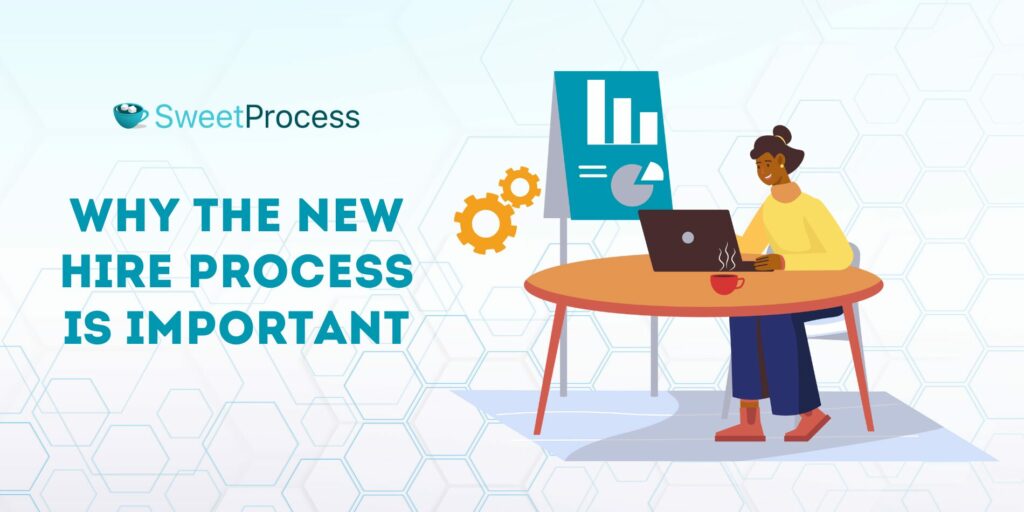
Investing in a strong new hire process is a smart investment in your company’s future. Here’s why it matters:
Drives Engagement and Accountability
Most people find starting a new job in a new environment intimidating. This is why you need to create a process that makes them feel comfortable and engaged. A well-structured onboarding program sets clear expectations and helps new hires feel invested in the company’s goals.
Additionally, engaged employees are more likely to take ownership of their work. This approach shows your willingness to invest in their growth. As a result, they become more accountable for results and valuable contributors.
Gives New Hires Time to Learn
Imagine starting a new sport without any practice. In the same way, you need a proper onboarding process that gives new hires the time and resources they need to learn the ropes of the job, including technical skills, company policies, and procedures.
According to Bamboo HR, 70% of new hires know whether the job is the perfect fit within a month, while 29% decide in the first week. Therefore, you need a learning management system starting from day one to avoid high turnovers. Have training manuals ready as early as possible for pre-boarding to boost confidence and reduce anxiety among your new team members.
Builds a Positive Work Culture
How does your company integrate new team members?
The first few weeks at a new job set the tone for the employee experience. A smooth and welcoming onboarding process sends a message that your company values its employees and invests in their success.
For instance, a new employee who receives proper support from the department, supervisors, and managers from the onset is more likely to engage fully and stay with the company longer. Ensure you have a hiring process that makes the new team members feel appreciated for better employee satisfaction.
Helps to Attract Quality Talent Easily
Word travels fast, especially in today’s job market. Therefore, you might get negative reviews if your onboarding process is ineffective. Candidates start making decisions about potential jobs during the interviewing and onboarding stages. Statistics show that 72% of job candidates consider how smooth the interview process is before making the final decision.
When prospective employees hear about a company’s commitment to effective onboarding and employee development, it strengthens their reputation as an employer of choice. This also gives you a significant edge in attracting top talent looking for supportive and growth-oriented work environments.
Increases Employee Productivity
The average productivity rate of new hires during the first month of employment and training is approximately 25%. This number goes up to 50% and 75% in the second and third month respectively. Why does this happen?
Simple. The sooner your new hires feel comfortable and confident in their roles, the sooner they can contribute to the bottom line. You can boost these productivity levels by providing training and development tools from day one. This support goes a long way in improving your employee retention rates in the long run.
How to Onboard New Employees To Your Company: A 9-Step Guide
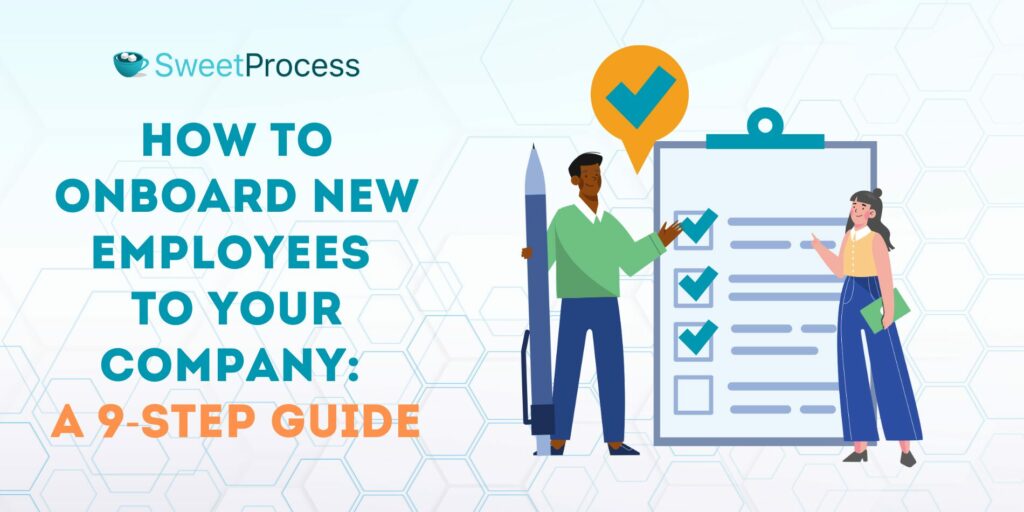
A solid onboarding process can make a huge difference in your company. It gives the first impression of how your organization operates. You want your new hires to feel welcomed, prepared, and motivated to contribute from the start. Here’s a nine-step guide to help you create a smooth and welcoming experience for your new hires.
Develop a Comprehensive Onboarding Plan
What happens when your new hire reports on the first day? Which tasks do they need to complete within the first week?
You can only answer these questions if you have a detailed onboarding plan that outlines each step of the process, from the initial introduction to full integration into the team. This plan should include:
- Timelines
- Responsibilities
- Specific objectives to ensure new hires receive all the necessary information and support.
- Training methods
Your onboarding plan should be comprehensive to ensure your new team members don’t miss any important details that can help with the integration.
Schedule and Conduct Orientation Sessions
Employee orientation sessions are a great way to introduce new hires to their colleagues and company culture. It’s necessary because it helps new hires understand the bigger picture and how they fit into the organization. Employees who fail to get proper orientation may feel isolated, leading to increased turnover rates.
During the orientation phase, you can provide information about the company’s history, mission, values, and an overview of different departments. For instance, if an individual is joining the marketing department, it’s a good time to introduce them to the rest of the team. Additionally, it’s also a perfect opportunity to answer any questions your new hires might have and provide them with essential company resources.
Share Your Company’s Policies and Procedures With the New Hires
You want your employees to be on the same page regarding policies and procedures. The onboarding phase is the best time to educate them about the policies they need to follow. To avoid non-compliance issues, you should cover guidelines on workplace behavior, attendance, communication protocols, and performance expectations.
To streamline the process, you can provide an employee handbook or training manual that covers all the vital business policies and procedures.
Form Social Connections With Colleagues
As the new person in the office, your new hire may need some time to settle in. You can speed up the process by encouraging social connections with the existing team. These introductions don’t always have to be formal. Break down the formalities by arranging team lunches or informal meet-and-greet sessions to help them build relationships and feel more comfortable in their new environment.
Social integration can boost the feeling of belonging and contribute positively to teamwork.
Stay in Touch Between the Offer and Start Date
The time between accepting the offer and the start date can feel like a long waiting game. A BambooHR survey shows that new hires who got an offer letter were 17 times more likely to report to work feeling more emotionally connected to the organization. Once you share the start date, maintain communication to keep new hires engaged and excited about their new role.
You can bridge this gap by sending welcome emails, company updates, or even a small welcome package to show that you are looking forward to their arrival.
Schedule a 1:1 Welcome Meeting
To eliminate the new job jitters, it’s good to plan a one-on-one welcome meeting with the new hire’s manager or a senior team member. This meeting provides an opportunity to discuss initial tasks, set expectations, and address any questions they might have. It’s also a good opportunity to establish a personal connection from the beginning.
For better interactions, you can organize one meeting with the specific departments and then another with the company executives or managers. This way, your hire has a complete overview of the company.
Set up Your New Hire’s Workspace
First impressions matter, and that includes their workspace. A well-equipped and personalized workspace ready for your new hires on their first day shows you value their contribution and care about their comfort and productivity. This includes setting up their desk, computer, phone, and any other necessary equipment needed to execute their role.
Take Care of Paperwork Swiftly
Preparing paperwork such as employment contracts, tax forms, and employee benefits enrollment can take a lot of time. However, it’s important to handle this task early on to avoid any administrative delays. Ensure you have all the documents ready before day one to make the onboarding process more seamless. With this in place, the new hires start their role without hiccups and focus on their job responsibilities.
Introduce Your New Hire to the Team
New hires often feel anxious about meeting their new colleagues. Facilitate formal introductions during a team meeting or through an email announcement. You can go further and plan personal introductions by organizing a tour around the office or planning coffee chats where everyone meets.
At the same time, encourage your current team members to be welcoming. This approach breaks the ice and integrates the new employee into the team dynamic.
7 Effective Ways to Integrate New Employees Into Your Company
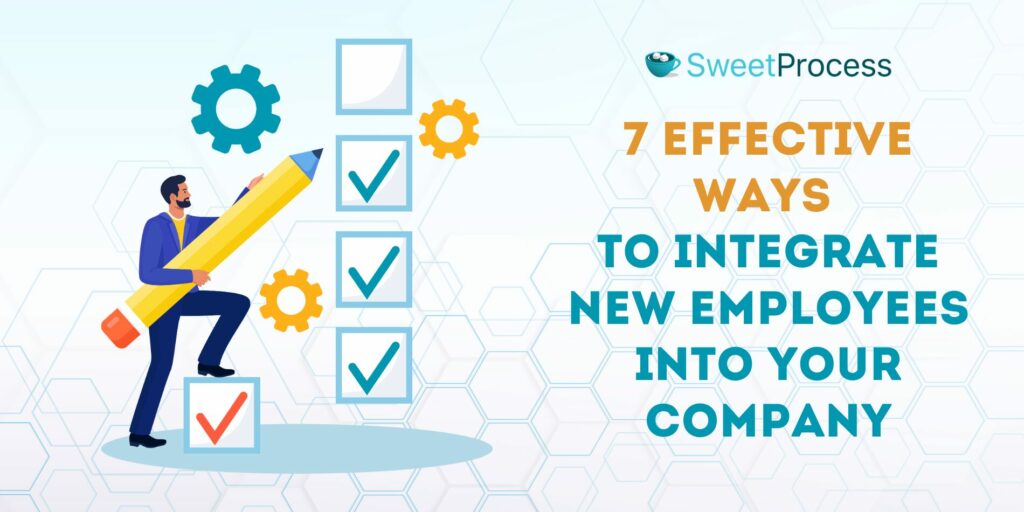
While onboarding focuses on the initial setup and knowledge transfer, integration is about helping your new hires become fully functioning and productive team members. How can you achieve seamless integration? Here are the key ways to get started:
Design Job-Specific Training Programs
If your new employee is joining the digital marketing team, they need a specific training guide that covers this role. The program should include the company’s content marketing strategies, SEO best practices, analytics tools, content calendars, and any other related information.
The program should go beyond the basics and provide the necessary tools the employee needs to excel. Investing in job-specific training helps your new hires quickly gain the confidence and competence for the role.
Assign an Onboarding Buddy or Mentor
Some of the successful companies use a buddy program to train and onboard new employees. Pairing new employees with an onboarding buddy or mentor can boost their integration experience. This person serves as a go-to resource for questions, offers guidance, and helps the new hire navigate the company culture and processes.
Set Clear Performance Expectations and Goals
Like every department has monthly targets, your employees also need clear performance expectations. To boost motivation, you can break down the details in the job description and clarify what’s expected of them. Furthermore, these expectations should be tailored to their level of experience and can be adjusted as the onboarding process continues. The advantage of defining goals is that you have a reference point to track progress.
Evaluate and Provide Constructive Feedback Regularly
Data by Gallup shows that 80% of team members who get meaningful feedback are more engaged in their work. These numbers clearly show that employees value this information. Regular evaluations and constructive feedback can help with the continuous development of new employees. Schedule check-ins and performance reviews to recognize achievements, address challenges, and offer guidance.
Monitor Employee Performance and Address Any Issues
It’s better to address problems early on before they escalate and become too costly for the company. Since they are new to the company, new hires are bound to make some mistakes. However, you can mitigate this problem by proactively monitoring their performance to identify and address any issues. For instance, if an employee is struggling with key tasks, you can offer additional support or assign a mentor to guide them.
Offer Opportunities for Internal Growth and Advancement
Ninety-two percent of employees say that high-quality training programs boost their engagement. Companies that offer such opportunities demonstrate a commitment to the employee’s long-term career and professional development. New hires want to see a future for themselves in the company; therefore, it’s advisable to provide additional training and certifications that can advance their skills. They might want to stick around a little longer if there’s a chance to get promoted to a better role.
Encourage Active Participation and Engagement
Don’t let your new hires feel like observers. Encourage them to actively participate in meetings, brainstorming sessions, and team projects. Your team might get a fresh perspective on current projects, which can motivate new employees. Additionally, these interactions will come in handy for building relationships with colleagues.
How to Ensure a Seamless New Hire Process Using SweetProcess
You can streamline your hiring process by integrating SweetProcess into your existing business systems. It provides automated tools for new hires to learn more about the company. The SweetProcess knowledge base can collect, store, and manage all training resources you need to onboard the new team members. You can also create checklists to ensure you don’t miss a step during the hiring process.
Try SweetProcess! Start the 14-day SweetProcess free trial today. No credit card is required!
Document and Manage your Company’s Policies in One Place
As part of the integration process, you need to educate your new hires about the policies and code of conduct that govern the company. SweetProcess will document and manage these policies for you. Here’s how:
- Open your SweetProcess account.
- Click “More” on the main menu.

- Select “Policies.”

- Select “Create Policy” on the next tab.

- Add the policy title and include the specific teams by ticking one of the boxes.
- Add the policy details.
- Alternatively, you can use SweetAI to automatically draft the policy.

Once you are done writing, you can embed videos or add files. Then click “Save Changes” to finish.
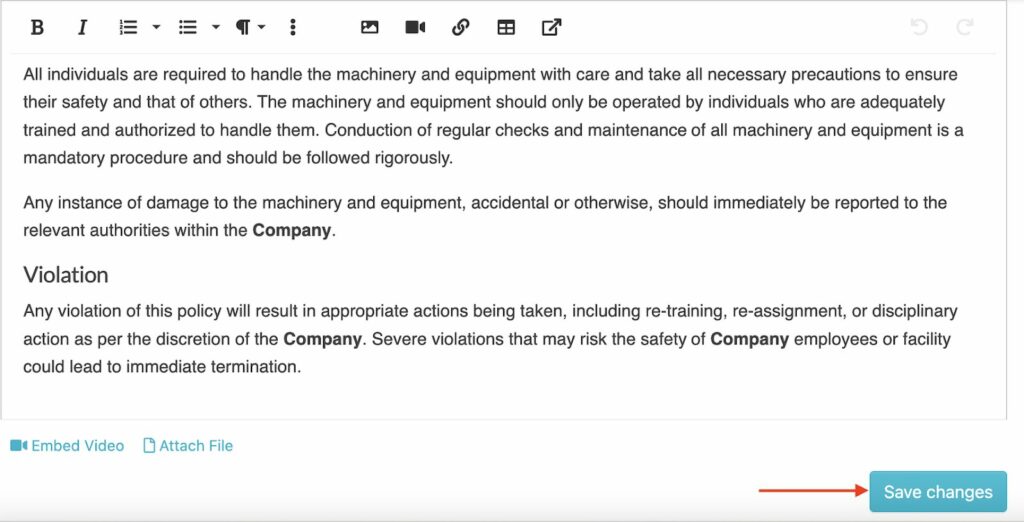
Your new hires can view every company policy just by clicking on the “Policies” tab.
SweetProcess is collaborative; therefore, every team member can give feedback and provide input.
If you want to assign the policy to specific new hires, click on the three dots on the right and select their names.
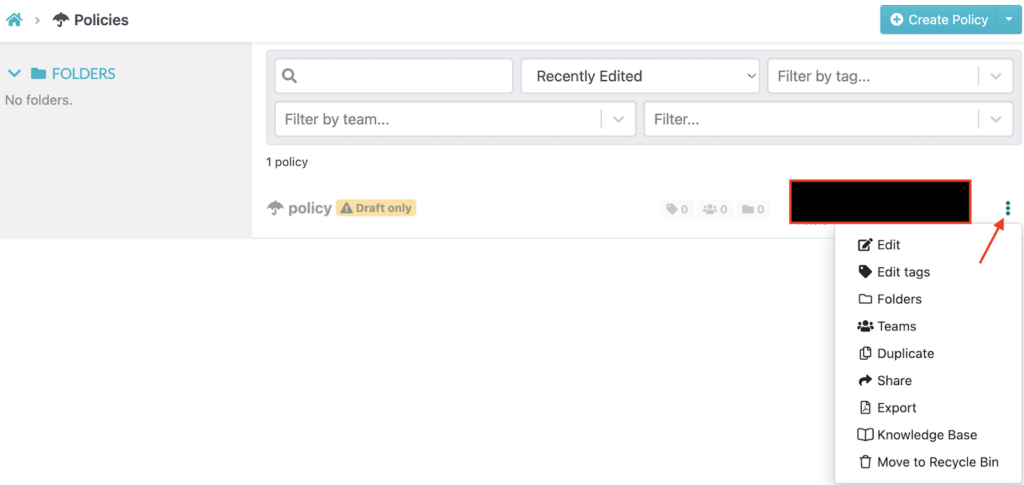
Create an Internal Knowledge Base for Employees
To facilitate continuous learning, you can use SweetProcess to create an internal knowledge base for your team. This resource is a go-to for new hires to access tutorials, FAQs, and key company information. Follow these steps:
- Select the “More” button on the main menu.
- Tap “Knowledge Bases.”
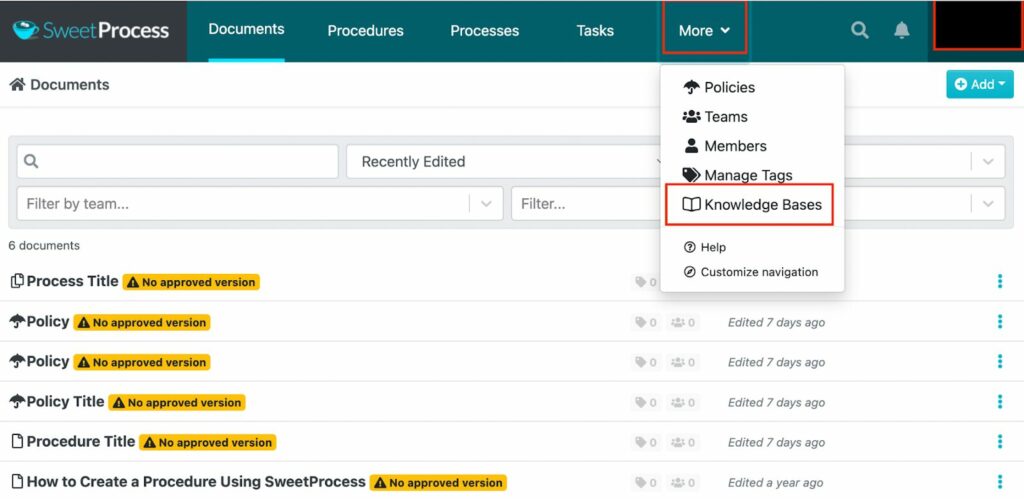
Include a title.

Tap on the pencil icon to edit your knowledge base.
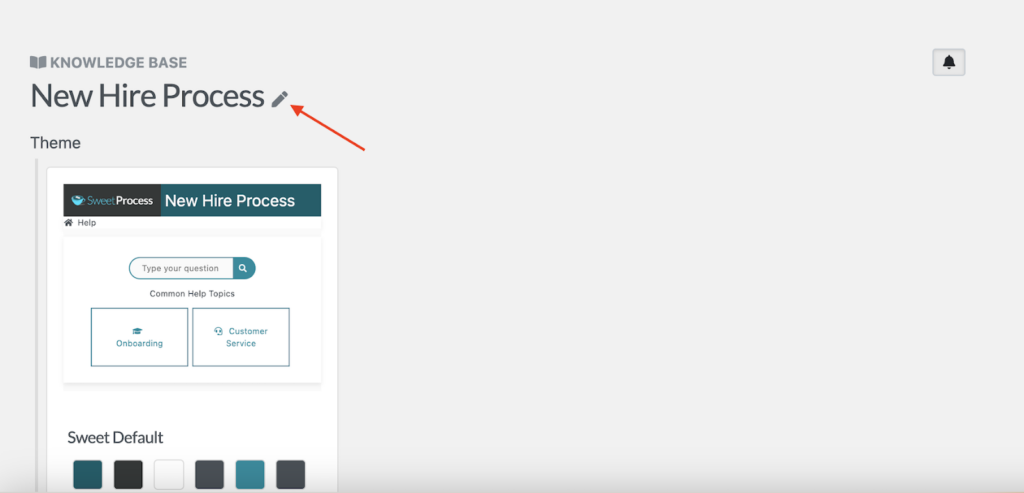
You can edit the control access to make it accessible only to the internal team and save changes.
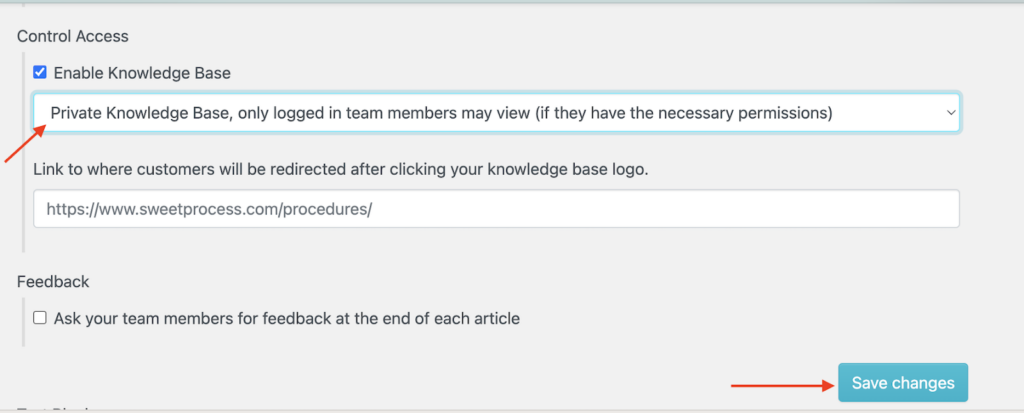
Streamline the Onboarding Process Using a Checklist
Thanks to the intuitive platform, you can create a comprehensive employee onboarding checklist. You can turn your procedure into a checklist.
- Click on the “Processes” tab.

- Add a title.
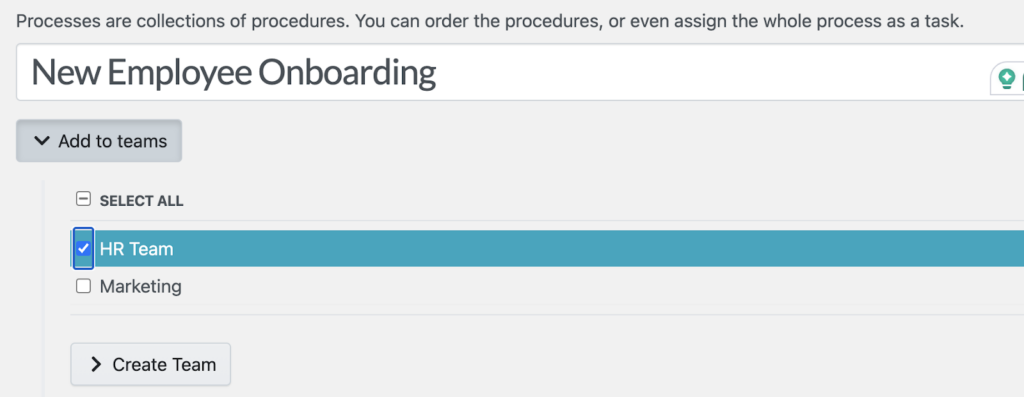
Include steps to your process to make the onboarding process comprehensive. To get started, tap “Add Step.”
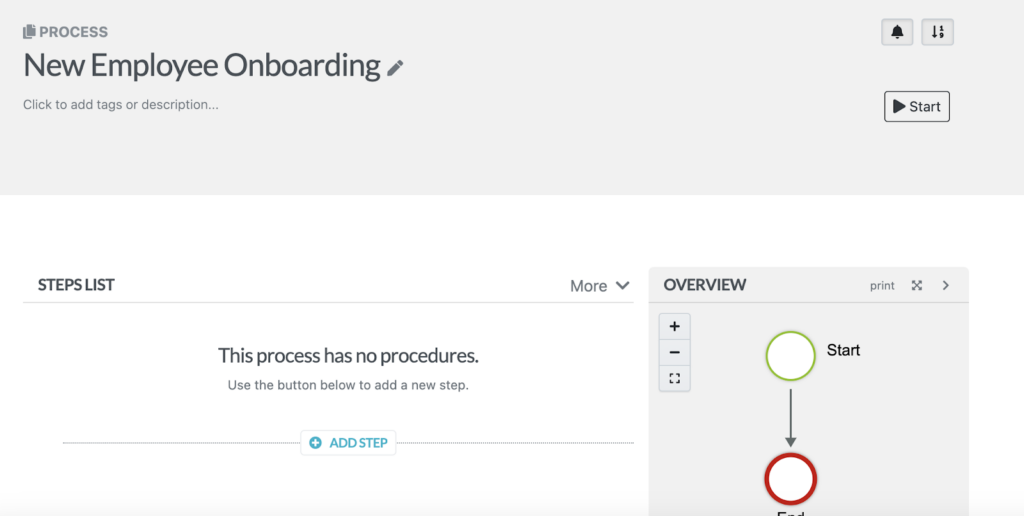
You can create a new procedure or use an existing one under each step. Add details to all the steps.
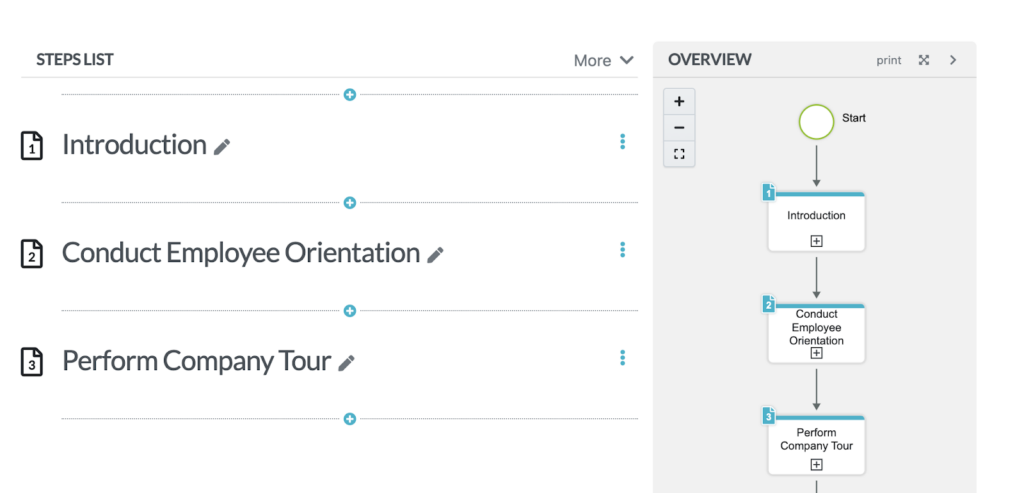
Select “Finish Editing” after adding all the steps. Click on “Approve” to make the process live.

Empower Employees With Your Company’s Procedures and Processes
Your new hires need to be knowledgeable about the company’s processes and procedures. SweetProcess makes this process more seamless.
- For procedures, tap the “Procedures” tab, then tap “Create Procedure.”

- Add a procedure title.

- Assign the procedure to specific or multiple teams.

- Add a procedure description.
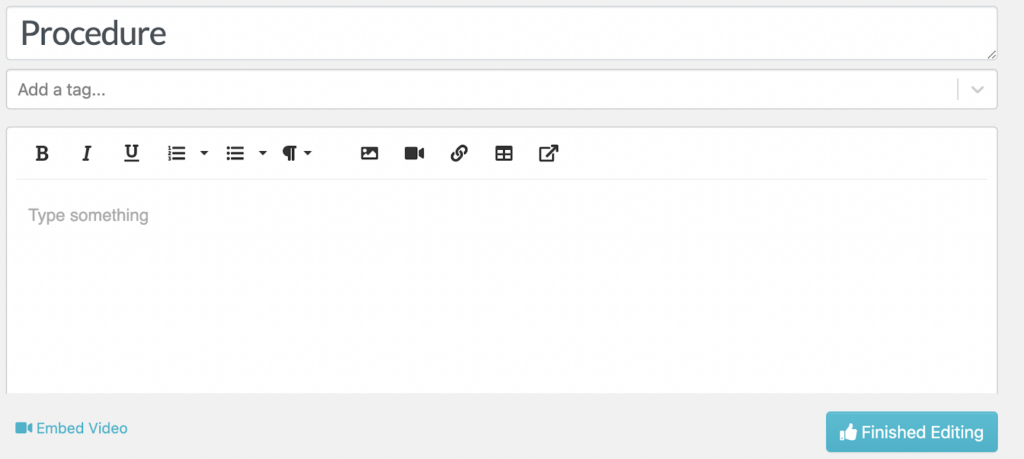
- Include your tags using keywords to identify or find your procedure easily.
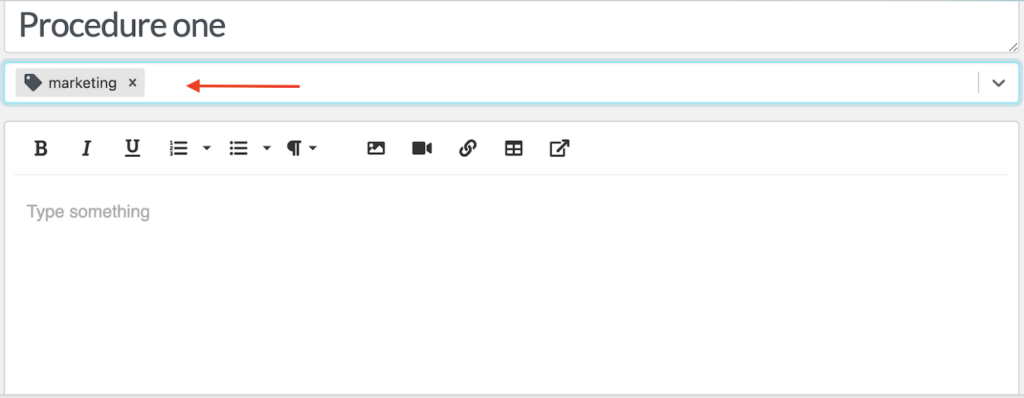
Alternatively, you can use SweetAI to create a procedure automatically within minutes. Add a title, and the procedure will be generated.
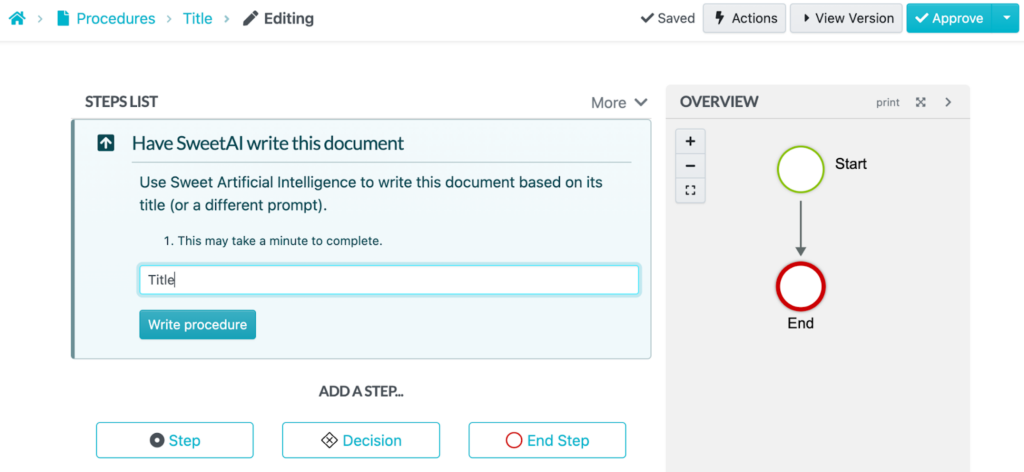
To make the procedure comprehensive, add images and videos.
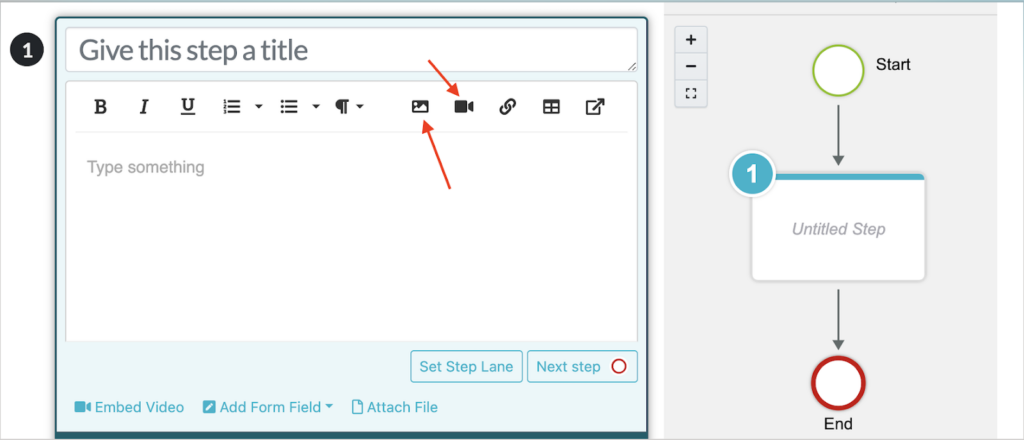
Click “Finished Editing” once you are done.
On the other hand, if you want to onboard new hires on a process, here’s how to use SweetProcess:
- Click “Processes” and select “Create Process.”

- Add the title.
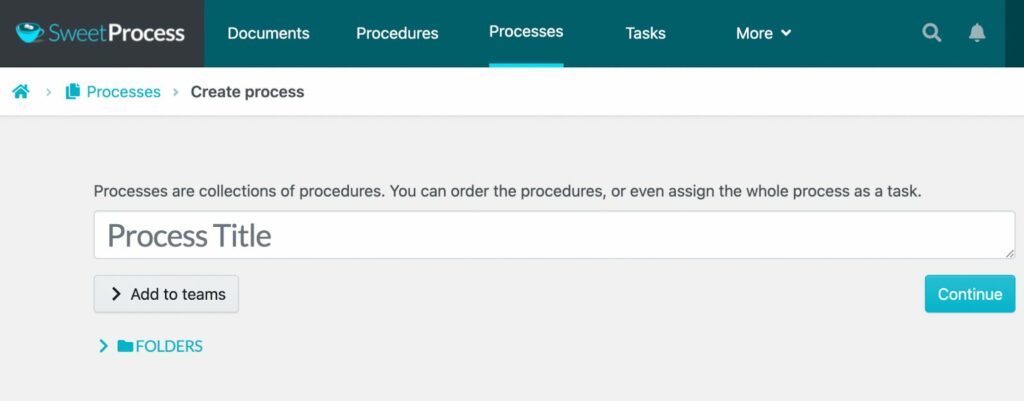
Include the details you need about the specific process to help with training.
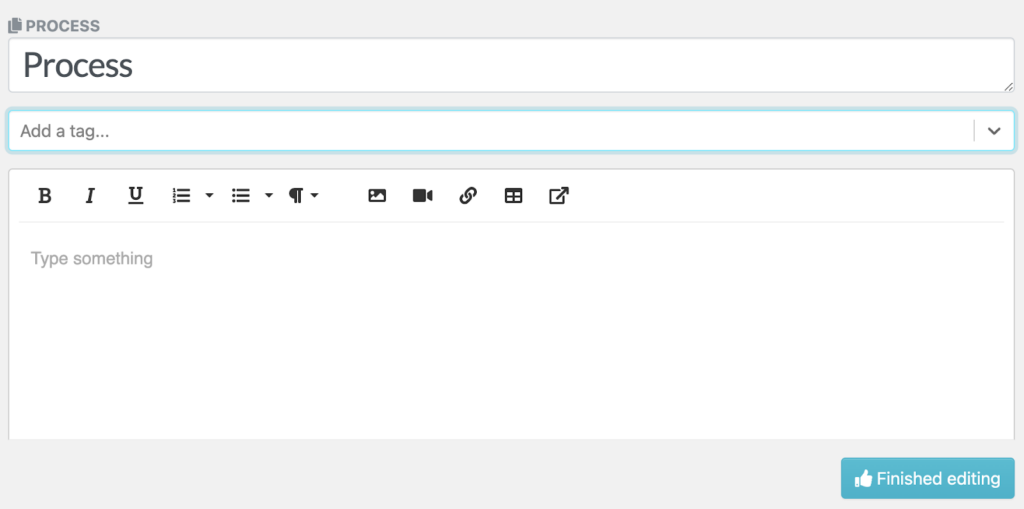
Once saved, the processes and procedures will be accessible from the dashboard. SweetProcess’s comprehensive search capabilities make it easy to find a specific document.

These features have made SweetProcess the go-to onboarding tool for some companies. One such organization is TechQuarters. The CEO, Chris Dunning, and operations director, Mark O’Dell, had been running the business for years; therefore, they had tribal knowledge about the company’s procedures and processes.
Because of this, the new hires couldn’t access the company’s knowledge without consulting them. To solve the problem, they started looking for a centralized system, which led them to SweetProcess.
Mark shares, “It allowed us to bring different types of media and different bits and pieces into the system. It wasn’t just a simple checklist thing. It allowed us to nest inside it. This task needs to be done, and now you can build a down button, and here’s how to do it in a procedural way, which could then include further questioning or further information.”
Since they started using SweetProcess, all the documentation has been in one place. New employees can access this knowledge base and get instructions about how to execute their roles, boosting efficiency.
SweetProcess has also been instrumental for companies like Zen Media. The chief marketing officer, Stephanie Chavez, had the objective of enhancing operations. While the company had proper documentation, there was a lack of uniformity, and the processes were scattered. Not all employees had access to company information, so they had to refer to specific team members for help.
This approach was slowing down operations, so Stephanie had to look for an alternative tool. With SweetProcess, the company now has a hiring and onboarding tool. They can train employees using the knowledge base. Additionally, there is more uniformity in task execution.
Your business needs an efficient onboarding tool to document your procedures, processes, and policies in one place. Start the 14-day SweetProcess free trial today. No credit card is required!
9 Best Practices and Tips for a Successful New Hire Process
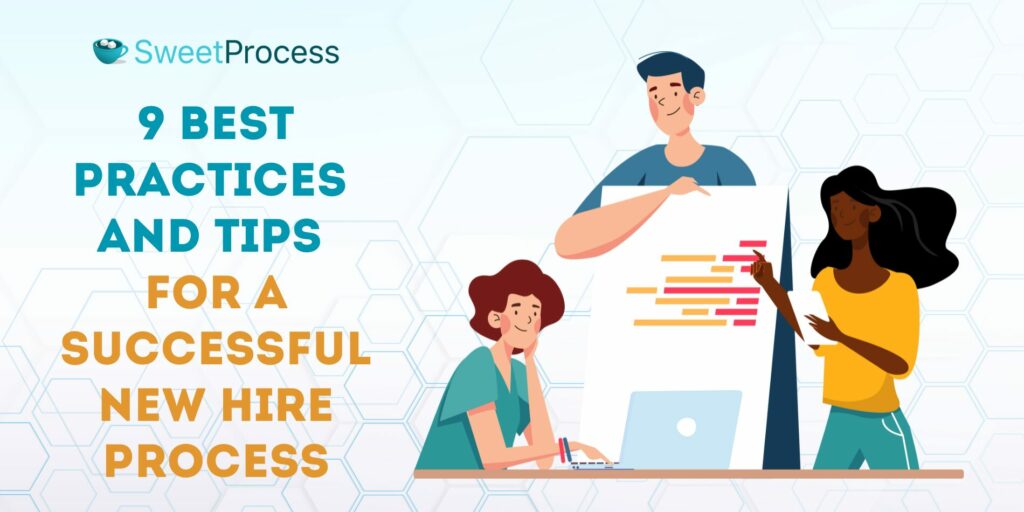
Now that you’ve got a roadmap for onboarding and integrating new hires, how can you ensure the process is successful? Here are some best practices and tips to guide you:
Align the Job Description and the Onboarding Plan
First impressions matter. The job description is among the first things the new hire will use to determine whether the job is a perfect fit. Therefore, ensure that the onboarding plan aligns closely with the job description. This approach helps set clear expectations from the outset and ensures that new hires understand their roles and responsibilities. Additionally, it provides a structured pathway for new employees to follow.
Use an Onboarding Checklist
An onboarding checklist ensures that you don’t miss a step. We all know the hiring process can be time-intensive, especially since the company needs to run as usual. However, with a checklist, you can monitor everything from the new hire paperwork and orientation sessions to training and social integration activities. It keeps everyone organized, creating a seamless experience for your new hire.
Ensure Consistency in the Onboarding Process
Onboarding should not be done only at the beginning; it should be continuous until the new hire is fully integrated. To improve it, you need to standardize the process and provide all the hires with the same level of support, training resources, and information. This is why you need knowledge-base software that documents all the processes, procedures, and checklists in a centralized location. Your team will be more unified if they get the same information.
Automate and Personalize the Onboarding Process
Technology is your friend in the onboarding process. You’ll realize that there are multiple repetitive processes, such as training sessions, sending welcome emails, and filling out forms. Make these tasks more seamless by adopting software and rolls that personalize the onboarding experience. These tools can tailor certain elements to the new hire’s specific role and needs. These tools will free up your time for more personalized interactions with your new hire.
Discuss Everything That Is Necessary and Skip What Is Not
You don’t want to overwhelm your new hire with too much information on the first day or week. Focus on providing the necessary information to start the job and then schedule the rest for the coming weeks. For instance, in the first week, you can tailor your onboarding experience to cover important company policies, key responsibilities, and job-specific training. With time, you can start bringing them into bigger company projects and assigning more tasks.
Provide All the Tools They Need to Do Their Job
If you are hiring a web developer, they will need access to a computer, software, networks, and other essential documentation to work on their job. It’s important to have these resources ready from day one. Preparing early prevents delays and frustration, allowing them to start contributing immediately.
Contact Your New Hire Before the First Day
Don’t wait until the first day to connect with your new hire. Maintain communication between the job offer and their start date. You can share a quick welcome email or video call during this period to keep them excited about joining the team. Additionally, this practice helps new hires feel engaged and reduces first-day anxieties.
Standardize the Welcome Packet
Multiple companies, including giants like Google, offer a welcome kit to new employees. Providing a standardized welcome pack can make new employees feel appreciated and excited about joining the team. You can have items such as company-branded merchandise, essential office supplies, a local coffee shop gift card, and an employee handbook. Personalize the welcome pack with a handwritten welcome note for a thoughtful touch.
Go Beyond the First Week
Although the first onboarding week is important, it shouldn’t stop there. You should extend this to even three to six months to ensure long-term integration and support. During this period, you can:
- Plan follow-up meetings
- Offer additional training sessions
- Organize regular check-ins
Continuous employee engagement helps new hires feel supported as they settle into their roles and contributes to long-term success.
7 Common Challenges You Might Encounter During the New Hire Process
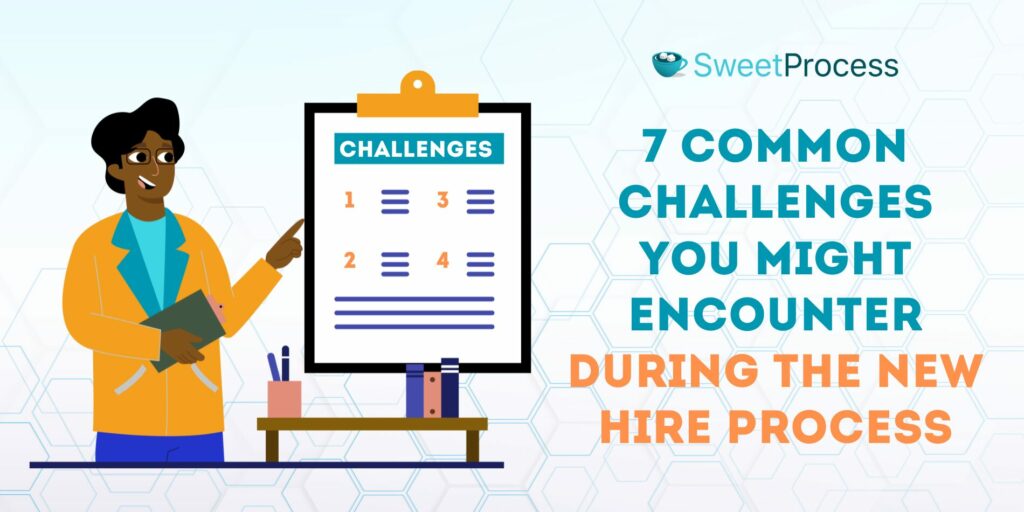
Even with a well-planned onboarding process, companies can encounter several challenges that hinder the effective integration of new employees. You need to understand these potential issues, which can help you improve your new hire process. Here are key challenges to be aware of:
Misleading Job Description
Data shows that 61% of job descriptions have vague requirements and unrealistic expectations, leading to a mismatch between the job and the candidate. Overpromising and under-delivering set the stage for disappointment and could influence employees to leave. The new hire will feel misled and lose trust in the company. To avoid this, ensure that job descriptions accurately reflect the role’s responsibilities and requirements.
Neglecting Feedback
Onboarding is a two-way street. As you give feedback, you should also actively seek feedback from your new hire. When you neglect feedback, you won’t know whether the process is efficient or helping with the integration process. With this information, you can answer questions, get their perspective, and make necessary adjustments. The best way to get feedback is by organizing regular check-ins with your new team members.
Providing Quality Information for New Hires
During the first days, your new employee will consume a lot of new information. They will attend meetings, team briefings, and training sessions with new faces. All this can be overwhelming and lead to information overload. Additionally, providing outdated or incomplete information can hinder their ability to integrate smoothly. Ensure that all training materials, resources, and company policies are up-to-date and easily accessible to new employees.
Neglecting to Explain How Your Employee Onboarding Software Works
If your company uses onboarding software, keep in mind that the new hire might not know how to navigate it. Failing to explain how it works can leave new hires confused and frustrated. Provide clear instructions and training on using the software until they become familiar with the tool. This approach helps them complete onboarding tasks efficiently by taking full advantage of its features.
Giving Too Much Information Too Quickly
As mentioned, you need to spread out your onboarding period. Providing too much information at once makes it difficult to retain important details. Prioritize essential topics first and gradually introduce additional information as they settle into their roles. This is why you need a checklist to guide you on which topics to introduce first.
Staying Consistent
Companies with an inconsistent onboarding process may be more likely to have errors and cause confusion among new employees. In addition, it could lead to frustration and make them feel unwelcome. For instance, if you have new hires for different departments, you need to have a general company onboarding process and then break it down to the respective departments for uniformity.
Addressing Cultural and Generational Differences
Just like your current team, your new hires will come from different generations and cultural backgrounds. If your company has the same learning and communication styles, it becomes challenging for everyone to integrate at the same pace. For instance, the younger generations prefer bit-sized information and online training resources for faster learning. Therefore, you need to be mindful of these differences and create an inclusive onboarding experience.
Bring Onboard New Employees Seamlessly With SweetProcess
Creating an efficient and effective employee onboarding process takes time and effort. However, it’s necessary if you want a well-integrated, engaged, and productive workforce. Once you have the plan, you can transition your new hires more seamlessly.
A tool like SweetProcess simplifies this process by providing a platform that centralizes all company information and resources.
With SweetProcess, you can automate repetitive tasks, provide clear instructions, and ensure consistency across your onboarding program.
Empower your new hires from day one! Sign up for a free 14-day trial of SweetProcess today and see how effortless onboarding can be. No credit card is required!

